List of mammals of Togo
This is a list of the mammal species recorded in Togo. Of the mammal species in Togo, four are endangered, eight are vulnerable, and three are near threatened.[1]
The following tags are used to highlight each species' conservation status as assessed by the International Union for Conservation of Nature:
| EX | Extinct | No reasonable doubt that the last individual has died. |
| EW | Extinct in the wild | Known only to survive in captivity or as a naturalized populations well outside its previous range. |
| CR | Critically endangered | The species is in imminent risk of extinction in the wild. |
| EN | Endangered | The species is facing an extremely high risk of extinction in the wild. |
| VU | Vulnerable | The species is facing a high risk of extinction in the wild. |
| NT | Near threatened | The species does not meet any of the criteria that would categorise it as risking extinction but it is likely to do so in the future. |
| LC | Least concern | There are no current identifiable risks to the species. |
| DD | Data deficient | There is inadequate information to make an assessment of the risks to this species. |
Some species were assessed using an earlier set of criteria. Species assessed using this system have the following instead of near threatened and least concern categories:
| LR/cd | Lower risk/conservation dependent | Species which were the focus of conservation programmes and may have moved into a higher risk category if that programme was discontinued. |
| LR/nt | Lower risk/near threatened | Species which are close to being classified as vulnerable but are not the subject of conservation programmes. |
| LR/lc | Lower risk/least concern | Species for which there are no identifiable risks. |
Order: Hyracoidea (hyraxes)
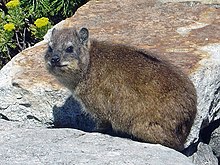
The hyraxes are any of four species of fairly small, thickset, herbivorous mammals in the order Hyracoidea. About the size of a domestic cat they are well-furred, with rounded bodies and a stumpy tail. They are native to Africa and the Middle East.
- Family: Procaviidae (hyraxes)
- Genus: Dendrohyrax
- Western tree hyrax, D. dorsalis LC
- Genus: Procavia
- Cape hyrax, P. capensis LC
- Genus: Dendrohyrax
- Family: Procaviidae (hyraxes)
Order: Proboscidea (elephants)
The elephants comprise three living species and are the largest living land animals.
- Family: Elephantidae (elephants)
- Genus: Loxodonta
- African forest elephant, L. cyclotis CR[2]
- Genus: Loxodonta
Order: Sirenia (manatees and dugongs)
Sirenia is an order of fully aquatic, herbivorous mammals that inhabit rivers, estuaries, coastal marine waters, swamps, and marine wetlands. All four species are endangered.
- Family: Trichechidae
- Genus: Trichechus
- African manatee, T. senegalensis VU
- Genus: Trichechus
Order: Primates

The order Primates contains humans and their closest relatives: lemurs, lorisoids, tarsiers, monkeys, and apes.
- Suborder: Strepsirrhini
- Infraorder: Lorisiformes
- Family: Lorisidae (lorises, bushbabies)
- Genus: Perodicticus
- Potto, Perodicticus potto LR/lc
- Genus: Perodicticus
- Family: Galagidae
- Genus: Galagoides
- Prince Demidoff's bushbaby, Galagoides demidovii LR/lc
- Genus: Galago
- Senegal bushbaby, Galago senegalensis LR/lc
- Genus: Galagoides
- Family: Lorisidae (lorises, bushbabies)
- Infraorder: Lorisiformes
- Suborder: Haplorhini
- Infraorder: Simiiformes
- Parvorder: Catarrhini
- Superfamily: Cercopithecoidea
- Family: Cercopithecidae (Old World monkeys)
- Genus: Erythrocebus
- Patas monkey, Erythrocebus patas LR/lc
- Genus: Chlorocebus
- Tantalus monkey, Chlorocebus tantalus LR/lc
- Genus: Cercopithecus
- Diana monkey, Cercopithecus diana EN
- White-throated guenon, Cercopithecus erythrogaster EN
- Mona monkey, Cercopithecus mona LR/lc
- Greater spot-nosed monkey, Cercopithecus nictitans LR/lc
- Lesser spot-nosed monkey, Cercopithecus petaurista LR/lc
- Genus: Papio
- Olive baboon, Papio anubis LR/lc
- Subfamily: Colobinae
- Genus: Colobus
- King colobus, Colobus polykomos LR/nt
- Ursine colobus, Colobus vellerosus VU
- Genus: Procolobus
- Olive colobus, Procolobus verus LR/nt
- Genus: Colobus
- Genus: Erythrocebus
- Family: Cercopithecidae (Old World monkeys)
- Superfamily: Hominoidea
- Family: Hominidae (great apes)
- Subfamily: Homininae
- Tribe: Hominini
- Subtribe: Hominina
- Subtribe: Chimpanzee
- Genus: Pan
- Common chimpanzee, Pan troglodytes EN
- Genus: Pan
- Tribe: Hominini
- Subfamily: Homininae
- Family: Hominidae (great apes)
- Superfamily: Cercopithecoidea
- Parvorder: Catarrhini
- Infraorder: Simiiformes
Order: Rodentia (rodents)

Rodents make up the largest order of mammals, with over 40% of mammalian species. They have two incisors in the upper and lower jaw which grow continually and must be kept short by gnawing. Most rodents are small though the capybara can weigh up to 45 kg (99 lb).
- Suborder: Hystricognathi
- Family: Hystricidae (Old World porcupines)
- Genus: Atherurus
- African brush-tailed porcupine, Atherurus africanus LC
- Genus: Hystrix
- Crested porcupine, Hystrix cristata LC
- Genus: Atherurus
- Family: Thryonomyidae (cane rats)
- Genus: Thryonomys
- Greater cane rat, Thryonomys swinderianus LC
- Genus: Thryonomys
- Family: Hystricidae (Old World porcupines)
- Suborder: Sciurognathi
- Family: Anomaluridae
- Subfamily: Anomalurinae
- Genus: Anomalurops
- Beecroft's scaly-tailed squirrel, Anomalurops beecrofti LC
- Genus: Anomalurops
- Subfamily: Anomalurinae
- Family: Sciuridae (squirrels)
- Subfamily: Xerinae
- Tribe: Xerini
- Genus: Xerus
- Striped ground squirrel, Xerus erythropus LC
- Genus: Xerus
- Tribe: Protoxerini
- Genus: Funisciurus
- Red-cheeked rope squirrel, Funisciurus leucogenys DD
- Kintampo rope squirrel, Funisciurus substriatus DD
- Genus: Heliosciurus
- Gambian sun squirrel, Heliosciurus gambianus LC
- Red-legged sun squirrel, Heliosciurus rufobrachium LC
- Genus: Protoxerus
- Forest giant squirrel, Protoxerus stangeri LC
- Genus: Funisciurus
- Tribe: Xerini
- Subfamily: Xerinae
- Family: Gliridae (dormice)
- Subfamily: Graphiurinae
- Genus: Graphiurus
- Jentink's dormouse, Graphiurus crassicaudatus DD
- Genus: Graphiurus
- Subfamily: Graphiurinae
- Family: Nesomyidae
- Subfamily: Dendromurinae
- Genus: Dendromus
- Banana climbing mouse, Dendromus messorius LC
- Genus: Steatomys
- Northwestern fat mouse, Steatomys caurinus LC
- Genus: Dendromus
- Subfamily: Cricetomyinae
- Genus: Cricetomys
- Emin's pouched rat, Cricetomys emini LC
- Gambian pouched rat, Cricetomys gambianus LC
- Genus: Cricetomys
- Subfamily: Dendromurinae
- Family: Muridae (mice, rats, voles, gerbils, hamsters, etc.)
- Subfamily: Leimacomyinae
- Genus: Leimacomys
- Togo mouse, Leimacomys buettneri DD
- Genus: Leimacomys
- Subfamily: Deomyinae
- Genus: Acomys
- Johan's spiny mouse, Acomys johannis LC
- Genus: Lophuromys
- Rusty-bellied brush-furred rat, Lophuromys sikapusi LC
- Genus: Uranomys
- Rudd's mouse, Uranomys ruddi LC
- Genus: Acomys
- Subfamily: Gerbillinae
- Genus: Tatera
- Kemp's gerbil, Tatera kempi LC
- Genus: Taterillus
- Gracile tateril, Taterillus gracilis LC
- Genus: Tatera
- Subfamily: Murinae
- Genus: Arvicanthis
- Sudanian grass rat, Arvicanthis ansorgei LC
- African grass rat, Arvicanthis niloticus LC
- Guinean grass rat, Arvicanthis rufinus LC
- Genus: Dasymys
- West African shaggy rat, Dasymys rufulus LC
- Genus: Hylomyscus
- Allen's wood mouse, Hylomyscus alleni LC
- Genus: Lemniscomys
- Typical striped grass mouse, Lemniscomys striatus LC
- Heuglin's striped grass mouse, Lemniscomys zebra LC
- Genus: Mastomys
- Guinea multimammate mouse, Mastomys erythroleucus LC
- Natal multimammate mouse, Mastomys natalensis LC
- Genus: Mus
- Matthey's mouse, Mus mattheyi LC
- African pygmy mouse, Mus minutoides LC
- Peters's mouse, Mus setulosus LC
- Genus: Praomys
- Dalton's mouse, Praomys daltoni LC
- Deroo's mouse, Praomys derooi LC
- Tullberg's soft-furred mouse, Praomys tullbergi LC
- Genus: Stochomys
- Target rat, Stochomys longicaudatus LC
- Genus: Arvicanthis
- Subfamily: Leimacomyinae
- Family: Anomaluridae
Order: Lagomorpha (lagomorphs)
The lagomorphs comprise two families, Leporidae (hares and rabbits), and Ochotonidae (pikas). Though they can resemble rodents, and were classified as a superfamily in that order until the early 20th century, they have since been considered a separate order. They differ from rodents in a number of physical characteristics, such as having four incisors in the upper jaw rather than two.
Order: Erinaceomorpha (hedgehogs and gymnures)
The order Erinaceomorpha contains a single family, Erinaceidae, which comprise the hedgehogs and gymnures. The hedgehogs are easily recognised by their spines while gymnures look more like large rats.
- Family: Erinaceidae (hedgehogs)
- Subfamily: Erinaceinae
- Genus: Atelerix
- Four-toed hedgehog, Atelerix albiventris LR/lc
- Genus: Atelerix
- Subfamily: Erinaceinae
Order: Soricomorpha (shrews, moles, and solenodons)
The "shrew-forms" are insectivorous mammals. The shrews and solenodons closely resemble mice while the moles are stout-bodied burrowers.
- Family: Soricidae (shrews)
- Subfamily: Crocidurinae
- Genus: Crocidura
- Crosse's shrew, Crocidura crossei LC
- Fox's shrew, Crocidura foxi LC
- Bicolored musk shrew, Crocidura fuscomurina LC
- Large-headed shrew, Crocidura grandiceps NT
- Lamotte's shrew, Crocidura lamottei LC
- Nigerian shrew, Crocidura nigeriae LC
- African giant shrew, Crocidura olivieri LC
- Fraser's musk shrew, Crocidura poensis LC
- Voi shrew, Crocidura voi LC
- Genus: Sylvisorex
- Climbing shrew, Sylvisorex megalura LC
- Genus: Crocidura
- Subfamily: Crocidurinae
Order: Chiroptera (bats)
The bats' most distinguishing feature is that their forelimbs are developed as wings, making them the only mammals capable of flight. Bat species account for about 20% of all mammals.
- Family: Pteropodidae (flying foxes, Old World fruit bats)
- Subfamily: Pteropodinae
- Genus: Eidolon
- Straw-coloured fruit bat, Eidolon helvum LC
- Genus: Epomophorus
- Gambian epauletted fruit bat, Epomophorus gambianus LC
- Genus: Epomops
- Franquet's epauletted fruit bat, Epomops franqueti LC
- Genus: Hypsignathus
- Hammer-headed bat, Hypsignathus monstrosus LC
- Genus: Lissonycteris
- Smith's fruit bat, Lissonycteris smithi LC
- Genus: Micropteropus
- Peters's dwarf epauletted fruit bat, Micropteropus pusillus LC
- Genus: Myonycteris
- Little collared fruit bat, Myonycteris torquata LC
- Genus: Nanonycteris
- Veldkamp's dwarf epauletted fruit bat, Nanonycteris veldkampi LC
- Genus: Rousettus
- Egyptian fruit bat, Rousettus aegyptiacus LC
- Genus: Eidolon
- Subfamily: Macroglossinae
- Genus: Megaloglossus
- Woermann's bat, Megaloglossus woermanni LC
- Genus: Megaloglossus
- Subfamily: Pteropodinae
- Family: Vespertilionidae
- Subfamily: Myotinae
- Genus: Myotis
- Rufous mouse-eared bat, Myotis bocagii LC
- Genus: Myotis
- Subfamily: Vespertilioninae
- Genus: Glauconycteris
- Abo bat, Glauconycteris poensis LC
- Butterfly bat, Glauconycteris variegata LC
- Genus: Mimetillus
- Moloney's mimic bat, Mimetillus moloneyi LC
- Genus: Neoromicia
- Cape serotine, Neoromicia capensis LC
- Tiny serotine, Neoromicia guineensis LC
- Banana pipistrelle, Neoromicia nanus LC
- Somali serotine, Neoromicia somalicus LC
- Genus: Nycticeinops
- Schlieffen's bat, Nycticeinops schlieffeni LC
- Genus: Scotophilus
- African yellow bat, Scotophilus dinganii LC
- White-bellied yellow bat, Scotophilus leucogaster LC
- Schreber's yellow bat, Scotophilus nigrita NT
- Greenish yellow bat, Scotophilus viridis LC
- Genus: Glauconycteris
- Subfamily: Myotinae
- Family: Molossidae
- Genus: Chaerephon
- Lappet-eared free-tailed bat, Chaerephon major LC
- Nigerian free-tailed bat, Chaerephon nigeriae LC
- Little free-tailed bat, Chaerephon pumila LC
- Genus: Mops
- Sierra Leone free-tailed bat, Mops brachypterus LC
- Angolan free-tailed bat, Mops condylurus LC
- Midas free-tailed bat, Mops midas LC
- Spurrell's free-tailed bat, Mops spurrelli LC
- Genus: Chaerephon
- Family: Emballonuridae
- Genus: Coleura
- African sheath-tailed bat, Coleura afra LC
- Genus: Taphozous
- Mauritian tomb bat, Taphozous mauritianus LC
- Naked-rumped tomb bat, Taphozous nudiventris LC
- Genus: Coleura
- Family: Nycteridae
- Genus: Nycteris
- Bate's slit-faced bat, Nycteris arge LC
- Gambian slit-faced bat, Nycteris gambiensis LC
- Large slit-faced bat, Nycteris grandis LC
- Hairy slit-faced bat, Nycteris hispida LC
- Large-eared slit-faced bat, Nycteris macrotis LC
- Dwarf slit-faced bat, Nycteris nana LC
- Egyptian slit-faced bat, Nycteris thebaica LC
- Genus: Nycteris
- Family: Megadermatidae
- Genus: Lavia
- Yellow-winged bat, Lavia frons LC
- Genus: Lavia
- Family: Rhinolophidae
- Subfamily: Rhinolophinae
- Genus: Rhinolophus
- Halcyon horseshoe bat, Rhinolophus alcyone LC
- Rüppell's horseshoe bat, Rhinolophus fumigatus LC
- Lander's horseshoe bat, Rhinolophus landeri LC
- Genus: Rhinolophus
- Subfamily: Hipposiderinae
- Genus: Hipposideros
- Aba roundleaf bat, Hipposideros abae NT
- Benito roundleaf bat, Hipposideros beatus LC
- Sundevall's roundleaf bat, Hipposideros caffer LC
- Cyclops roundleaf bat, Hipposideros cyclops LC
- Giant roundleaf bat, Hipposideros gigas LC
- Noack's roundleaf bat, Hipposideros ruber LC
- Genus: Hipposideros
- Subfamily: Rhinolophinae
Order: Pholidota (pangolins)
The order Pholidota comprises the eight species of pangolin. Pangolins are anteaters and have the powerful claws, elongated snout and long tongue seen in the other unrelated anteater species.
- Family: Manidae
- Genus: Manis
- Giant pangolin, S. gigantea EN[3]
- Genus: Phataginus
- Long-tailed pangolin, P. tetradactyla VU[4]
- Tree pangolin, P. tricuspis EN[5]
- Genus: Manis
Order: Cetacea (whales)
The order Cetacea includes whales, dolphins and porpoises. They are the mammals most fully adapted to aquatic life with a spindle-shaped nearly hairless body, protected by a thick layer of blubber, and forelimbs and tail modified to provide propulsion underwater.
- Suborder: Mysticeti
- Family: Balaenopteridae
- Subfamily: Balaenopterinae
- Genus: Balaenoptera
- Common minke whale, Balaenoptera acutorostrata VU
- Sei whale, Balaenoptera borealis EN
- Bryde's whale, Balaenoptera brydei EN
- Blue whale, Balaenoptera musculus EN
- Fin whale, Balaenoptera physalus EN
- Genus: Balaenoptera
- Subfamily: Megapterinae
- Genus: Megaptera
- Humpback whale, Megaptera novaeangliae VU
- Genus: Megaptera
- Subfamily: Balaenopterinae
- Family: Balaenopteridae
- Suborder: Odontoceti
- Superfamily: Platanistoidea
- Family: Phocoenidae
- Genus: Phocoena
- Harbour porpoise, Phocoena phocoena VU
- Genus: Phocoena
- Family: Physeteridae
- Genus: Physeter
- Sperm whale, Physeter macrocephalus VU
- Genus: Physeter
- Family: Kogiidae
- Genus: Kogia
- Pygmy sperm whale, Kogia breviceps DD
- Dwarf sperm whale, Kogia sima DD
- Genus: Kogia
- Family: Ziphidae
- Genus: Mesoplodon
- Blainville's beaked whale, Mesoplodon densirostris DD
- Gervais' beaked whale, Mesoplodon europaeus DD
- Genus: Ziphius
- Cuvier's beaked whale, Ziphius cavirostris DD
- Genus: Mesoplodon
- Family: Delphinidae (marine dolphins)
- Genus: Orcinus
- Killer whale, Orcinus orca DD
- Genus: Feresa
- Pygmy killer whale, Feresa attenuata DD
- Genus: Pseudorca
- False killer whale, Pseudorca crassidens DD
- Genus: Delphinus
- Short-beaked common dolphin, Delphinus delphis LR/cd
- Long-beaked common dolphin, Delphinus capensis DD
- Genus: Sousa
- Atlantic humpback dolphin, Sousa teuszii DD
- Genus: Lagenodelphis
- Fraser's dolphin, Lagenodelphis hosei DD
- Genus: Stenella
- Pantropical spotted dolphin, Stenella attenuata LR/cd
- Clymene dolphin, Stenella clymene DD
- Striped dolphin, Stenella coeruleoalba DD
- Atlantic spotted dolphin, Stenella frontalis DD
- Spinner dolphin, Stenella longirostris LR/cd
- Genus: Steno
- Rough-toothed dolphin, Steno bredanensis DD
- Genus: Tursiops
- Common bottlenose dolphin, Tursiops truncatus LC
- Genus: Globicephala
- Short-finned pilot whale, Globicephala macrorhynchus DD
- Genus: Grampus
- Risso's dolphin, Grampus griseus DD
- Genus: Peponocephala
- Melon-headed whale, Peponocephala electra DD
- Genus: Orcinus
- Family: Phocoenidae
- Superfamily: Platanistoidea
Order: Carnivora (carnivorans)

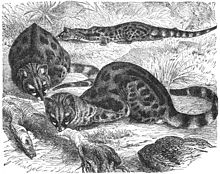
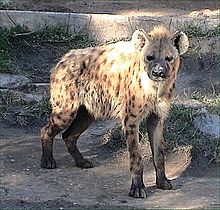
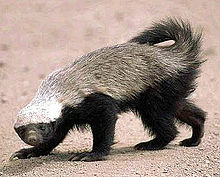
There are over 260 species of carnivorans, the majority of which feed primarily on meat. They have a characteristic skull shape and dentition.
- Suborder: Feliformia
- Family: Felidae (cats)
- Subfamily: Felinae
- Genus: Acinonyx
- Cheetah, A. jubatus VU presence uncertain
- Genus: Caracal
- Caracal, C. caracal LC[6]
- African golden cat, C. aurata VU presence uncertain[7]
- Genus: Leptailurus
- Serval, Leptailurus serval LC
- Genus: Acinonyx
- Subfamily: Felinae
- Family: Viverridae
- Subfamily: Viverrinae
- Genus: Genetta
- Common genet, G. genetta LC[8]
- Rusty-spotted genet, G. maculata LC[9]
- Hausa genet, G. thierryi LC
- Genus: Genetta
- Subfamily: Viverrinae
- Family: Nandiniidae
- Genus: Nandinia
- African palm civet, Nandinia binotata
- Genus: Nandinia
- Family: Herpestidae (mongooses)
- Genus: Herpestes
- Egyptian mongoose, Herpestes ichneumon LC
- Common slender mongoose, Herpestes sanguineus LC
- Genus: Mungos
- Gambian mongoose, Mungos gambianus DD
- Genus: Herpestes
- Family: Hyaenidae (hyaenas)
- Genus: Crocuta
- Spotted hyena, C. crocuta LC possibly extirpated[10]
- Genus: Crocuta
- Family: Felidae (cats)
- Suborder: Caniformia
- Family: Canidae (dogs, foxes)
- Genus: Lycaon
- African wild dog, L. pictus EN possibly extirpated
- Genus: Lycaon
- Family: Mustelidae (mustelids)
- Genus: Ictonyx
- Striped polecat, Ictonyx striatus LC
- Genus: Mellivora
- Honey badger, M. capensis LC[11]
- Genus: Hydrictis
- Speckle-throated otter, H. maculicollis NT possibly extirpated
- Genus: Ictonyx
- Family: Canidae (dogs, foxes)
Order: Artiodactyla (even-toed ungulates)
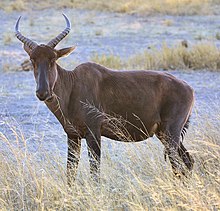
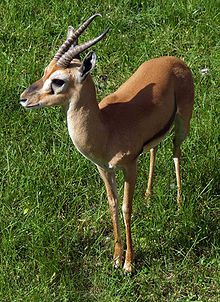
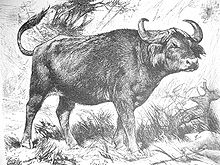

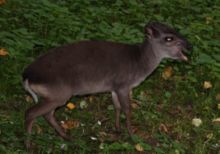

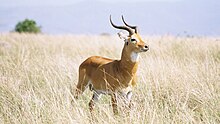
The even-toed ungulates are ungulates whose weight is borne about equally by the third and fourth toes, rather than mostly or entirely by the third as in perissodactyls. There are about 220 artiodactyl species, including many that are of great economic importance to humans.
- Family: Suidae (pigs)
- Subfamily: Phacochoerinae
- Genus: Phacochoerus
- Common warthog, Phacochoerus africanus LR/lc
- Genus: Phacochoerus
- Subfamily: Suinae
- Genus: Potamochoerus
- Red river hog, Potamochoerus porcus LR/lc
- Genus: Potamochoerus
- Subfamily: Phacochoerinae
- Family: Hippopotamidae (hippopotamuses)
- Genus: Hippopotamus
- Hippopotamus, Hippopotamus amphibius VU
- Genus: Hippopotamus
- Family: Tragulidae
- Genus: Hyemoschus
- Water chevrotain, Hyemoschus aquaticus DD
- Genus: Hyemoschus
- Family: Bovidae (cattle, antelope, sheep, goats)
- Subfamily: Alcelaphinae
- Genus: Alcelaphus
- Hartebeest, Alcelaphus buselaphus LR/cd
- Genus: Damaliscus
- Topi, Damaliscus lunatus LR/cd
- Genus: Alcelaphus
- Subfamily: Antilopinae
- Genus: Gazella
- Red-fronted gazelle, Gazella rufifrons VU
- Genus: Ourebia
- Oribi, Ourebia ourebi LR/cd
- Genus: Gazella
- Subfamily: Bovinae
- Genus: Syncerus
- African buffalo, Syncerus caffer LR/cd
- Genus: Tragelaphus
- Genus: Syncerus
- Subfamily: Cephalophinae
- Genus: Cephalophus
- Bay duiker, Cephalophus dorsalis LR/nt
- Maxwell's duiker, Cephalophus maxwellii LR/nt
- Blue duiker, Cephalophus monticola LR/lc
- Black duiker, Cephalophus niger LR/nt
- Red-flanked duiker, Cephalophus rufilatus LR/cd
- Yellow-backed duiker, Cephalophus silvicultor LR/nt
- Genus: Sylvicapra
- Common duiker, Sylvicapra grimmia LR/lc
- Genus: Cephalophus
- Subfamily: Hippotraginae
- Genus: Hippotragus
- Roan antelope, Hippotragus equinus LR/cd
- Genus: Hippotragus
- Subfamily: Reduncinae
- Genus: Kobus
- Genus: Redunca
- Bohor reedbuck, Redunca redunca LR/cd
- Subfamily: Alcelaphinae
Extirpated
The following species are locally extinct in the country:
- Lion, Panthera leo[12]
- Leopard, Panthera pardus[13]
- Giant eland, Tragelaphus derbianus
See also
- List of chordate orders
- Lists of mammals by region
- Mammal classification
- List of mammals described in the 2000s
References
- ^ This list is derived from the IUCN Red List which lists species of mammals and includes those mammals that have recently been classified as extinct (since 1500 AD). The taxonomy and naming of the individual species is based on those used in existing Wikipedia articles as of 21 May 2007 and supplemented by the common names and taxonomy from the IUCN, Smithsonian Institution, or University of Michigan where no Wikipedia article was available.
- ^ Gobush, K.S.; Edwards, C.T.T.; Balfour, D.; Wittemyer, G.; Maisels, F.; Taylor, R.D. (2021). "Loxodonta africana". IUCN Red List of Threatened Species. 2021: e.T181008073A204401095. doi:10.2305/IUCN.UK.2021-2.RLTS.T181008073A204401095.en. Retrieved 18 November 2021.
- ^ Nixon, S.; Pietersen, D.; Challender, D.; Hoffmann, M.; Godwill Ichu, I.; Bruce, T.; Ingram, D.J.; Matthews, N. & Shirley, M.H. (2019). "Smutsia gigantea". IUCN Red List of Threatened Species. 2019: e.T12762A123584478.
- ^ Ingram, D.J.; Shirley, M.H.; Pietersen, D.; Godwill Ichu, I.; Sodeinde, O.; Moumbolou, C.; Hoffmann, M.; Gudehus, M. & Challender, D. (2019). "Phataginus tetradactyla". IUCN Red List of Threatened Species. 2019: e.T12766A123586126.
- ^ Pietersen, D.; Moumbolou, C.; Ingram, D.J.; Soewu, D.; Jansen, R.; Sodeinde, O.; Keboy Mov Linkey Iflankoy, C.; Challender, D. & Shirley, M.H. (2019). "Phataginus tricuspis". IUCN Red List of Threatened Species. 2019: e.T12767A123586469.
- ^ Avgan, B.; Henschel, P. & Ghoddousi, A. (2016). "Caracal caracal". IUCN Red List of Threatened Species. 2016: e.T3847A102424310.
- ^ Bahaa-el-din, L.; Mills, D.; Hunter, L. & Henschel, P. (2015). "Caracal aurata". IUCN Red List of Threatened Species. 2015: e.T18306A50663128.
- ^ Gaubert, P.; Carvalho, F.; Camps, D. & Do Linh San, E. (2015). "Genetta genetta". IUCN Red List of Threatened Species. 2015: e.T41698A45218636.
- ^ Angelici, F.M.; Gaubert, P. & Do Linh San, E. (2016). "Genetta maculata". IUCN Red List of Threatened Species. 2016: e.T41699A45218948.
- ^ Bohm, T. & Höner, O.R. (2015). "Crocuta crocuta". IUCN Red List of Threatened Species. 2015: e.T5674A45194782.
- ^ Do Linh San, E.; Begg, C.; Begg, K. & Abramov, A. V. (2016). "Mellivora capensis". IUCN Red List of Threatened Species. 2016: e.T41629A45210107.
- ^ Henschel, P.; Bauer, H.; Sogbohoussou, E. & Nowell, K. (2016). "Panthera leo (West Africa subpopulation)". IUCN Red List of Threatened Species. 2016: e.T68933833A54067639.
- ^ Stein, A.B.; Athreya, V.; Gerngross, P.; Balme, G.; Henschel, P.; Karanth, U.; Miquelle, D.; Rostro-Garcia, S.; Kamler, J. F.; Laguardia, A.; Khorozyan, I. & Ghoddousi, A. (2020). "Panthera pardus". IUCN Red List of Threatened Species. 2020: e.T15954A163991139.
External links
- "Animal Diversity Web". University of Michigan Museum of Zoology. 1995–2006. Retrieved 22 May 2007.
